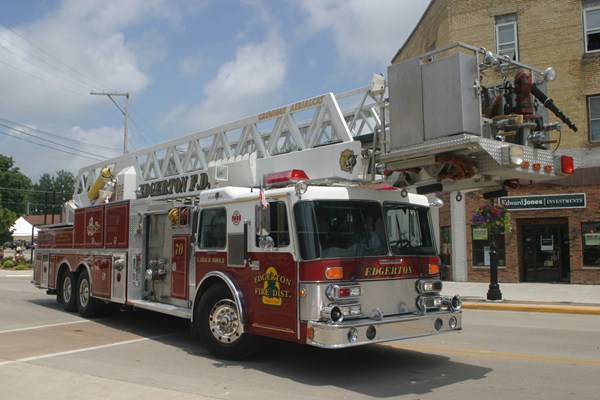
Soldiers who served in Wisconsin Territory during the 1832 Black Hawk War returned to their homes in the east with glowing descriptions of this area's beautiful prairies, burr oak openings, and swift sparkling streams. The Milton area was known then as Prairie du Lac (Prairie of the Lakes), but the description these men brought back called it "a veritable modern Eden." By the end of the decade, settlement had begun here. When Prairie du Lac applied for a post office in 1839, the territorial governor rejected the name as being too similar to the already established community of Prairie du Sac. At a meeting held to decide on a name, one settler remarked that when he left his home in the east, he thought of it as "Paradise Lost," but when he saw where Milton now stands, he called it "Paradise Regained." So the town was named for the author of "Paradise Lost," the poet John Milton.
Joseph Goodrich founded Milton and built the first frame house here. But his legacy is his 1844 hexagonal stagecoach inn, the Milton House, the first poured grout building in the United States. Today, it is a National Historic Landmark, the oldest concrete building still standing in the U.S., and one of 14 recognized stations on the Underground Railroad. Goodrich was a staunch abolitionist and the inn has a tunnel beneath it that provided a hiding place for runaway slaves. Today, the Milton House is a museum, with tours conducted by the Milton Historical Society.
One mile to the west of Milton, a second community called West Milton was settled. In the 1850s, two railroads were built through West Milton. This crossing of the two roads led to the community changing its name to Milton Junction. Milton and Milton Junction operated as separate communities until a merger in 1967. To this day, there are still two downtown areas in Milton: Parkview Drive on the east side of the city and Merchants Row in the old Milton Junction area to the west.
1844 was a busy year for Goodrich. Besides building the Milton House, he also built and founded Milton Academy, which evolved into Milton College. For 138 years, it was a prestigious private institution until financial troubles caused its closing in 1982. It had been the oldest college in the State of Wisconsin. Today, several of the college buildings have found new life as antique shops, offices, apartments, and the city library. For National Football League fans, however, Milton College's name lived on through the 1990s, as 1980 graduate Dave Krieg enjoyed fame as a star quarterback for the Seattle Seahawks.
The City of Milton adopted the slogan & History in Progress; in 1999. The two themes represented in this slogan mirror the strengths of our city.
The City of Milton takes great pride in its past: our documented link to the Underground Railroad, the lore and legacy of Milton College (1844-1982), a tradition of railroad traffic in the city, the beautiful churches which dot our landscape, and the widely known and appreciated tourist opportunities in our area. Our most distinctive historical gem, the Milton House National Historic Landmark, is proudly featured on our city logo.
Milton recognizes that today’s progress is what makes tomorrow’s history. The city uses its history to build its future as a significant community in south central Wisconsin. Annual community social events bring thousands of visitors to Milton every year. Businesses find our city to be a great place of opportunity, and we are a growing industrial hub. The railroad has strengthened Milton’s economy since 1852 and continues to do so today.
https://www.milton-wi.gov/